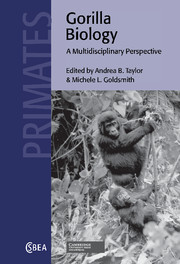Book contents
- Frontmatter
- Contents
- List of contributors
- Acknowledgments
- Epigraph
- Introduction: Gorilla biology: Multiple perspectives on variation within a genus
- Part 1 Gorilla taxonomy and comparative morphology
- Part 2 Molecular genetics
- Part 3 Behavioral ecology
- 11 An introductory perspective: Behavioral ecology of gorillas
- 12 Gorilla social relationships: A comparative overview
- 13 Within-group feeding competition and socioecological factors influencing social organization of gorillas in the Kahuzi-Biega National Park, Democratic Republic of Congo
- 14 Comparative behavioral ecology of a lowland and highland gorilla population: Where do Bwindi gorillas fit?
- 15 Are gorillas vacuum cleaners of the forest floor? The roles of body size, habitat, and food preferences on dietary flexibility and nutrition
- Part 4 Gorilla conservation
- Afterword
- Index
- References
12 - Gorilla social relationships: A comparative overview
Published online by Cambridge University Press: 11 August 2009
- Frontmatter
- Contents
- List of contributors
- Acknowledgments
- Epigraph
- Introduction: Gorilla biology: Multiple perspectives on variation within a genus
- Part 1 Gorilla taxonomy and comparative morphology
- Part 2 Molecular genetics
- Part 3 Behavioral ecology
- 11 An introductory perspective: Behavioral ecology of gorillas
- 12 Gorilla social relationships: A comparative overview
- 13 Within-group feeding competition and socioecological factors influencing social organization of gorillas in the Kahuzi-Biega National Park, Democratic Republic of Congo
- 14 Comparative behavioral ecology of a lowland and highland gorilla population: Where do Bwindi gorillas fit?
- 15 Are gorillas vacuum cleaners of the forest floor? The roles of body size, habitat, and food preferences on dietary flexibility and nutrition
- Part 4 Gorilla conservation
- Afterword
- Index
- References
Summary
Introduction
Research on mountain gorillas (Gorilla gorilla beringei) in the Virunga Volcanoes region of Rwanda, Uganda, and the Democratic Republic of Congo provides one of the best case studies of nonhuman primate behavior in the wild. Data on mountain gorilla ecology, life-history tactics, and social relationships, collected mainly at the Karisoke Research Center in Rwanda's Parc National des Volcans, have contributed prominently to the development of theory in primate socioecology (e.g., van Schaik, 1989; Sterck et al., 1997). For example, the association of female transfer with low levels of contest competition for food in mountain gorillas (Stewart and Harcourt, 1987; Watts, 1990a, 1994a, 1996, 1997) supports ideas on the ecology of female social relationships (van Schaik, 1989). Also, the influence of infanticide on transfer decisions (Watts, 1989, 1996) supports current ideas on male–female association and social relationships (Sterck et al., 1997). Important generalizations from the Virunga population seem to apply to other gorilla populations and subspecies, but we know that feeding ecology varies considerably across habitats and subspecies and face intriguing questions about variation in social organization and social relationships. However, while good comparative data on feeding ecology exist for eastern lowland gorillas (G. g. graueri; reviewed in Yamagiwa et al., 1996) and western lowland gorillas (G. g. gorilla; reviewed in Doran and McNeilage, 1998), we lack comparably detailed data on social behavior, demography, and life-history tactics.
- Type
- Chapter
- Information
- Gorilla BiologyA Multidisciplinary Perspective, pp. 302 - 327Publisher: Cambridge University PressPrint publication year: 2002
References
- 1
- Cited by

